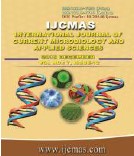


 National Academy of Agricultural Sciences (NAAS)
National Academy of Agricultural Sciences (NAAS)

|
PRINT ISSN : 2319-7692
Online ISSN : 2319-7706 Issues : 12 per year Publisher : Excellent Publishers Email : editorijcmas@gmail.com / submit@ijcmas.com Editor-in-chief: Dr.M.Prakash Index Copernicus ICV 2018: 95.39 NAAS RATING 2020: 5.38 |
In the present study, exposure assessment of Bacillus cereus associated with the consumption of street vended chicken briyani sold in Koduvalli village, Ellapuram block, Thiruvallur district, Tamil Nadu was assessed. Enumeration of B. cereus in chicken briyani was carried out using Hichrome Bacillus Agar, a chromogenic media by adopting pour plate technique. Data on frequency of consumption of chicken biryani by the residents were collected using a structured questionnaire. The results revealed that the Bacillus cereus count in street vended chicken briyani was ranged between 2.32 to 5.54 log cfu/g of sample. The mean B. cereus count was 4.03 log cfu/g of sample. Invariably, all the samples analyzed were contained B. cereus. Similarly, the consumption pattern showed that the people at the age group of 20-35, 35-60 and 60 and above were consumed about 450 g of chicken briyani during each serve. This clearly indicate their higher vulnerability of these age groups to diarrhoeal syndrome followed by children at the age group of 5-12 and 13-19 who consumed 300 g of chicken briyani during each serve.
 |
 |
 |
 |
 |